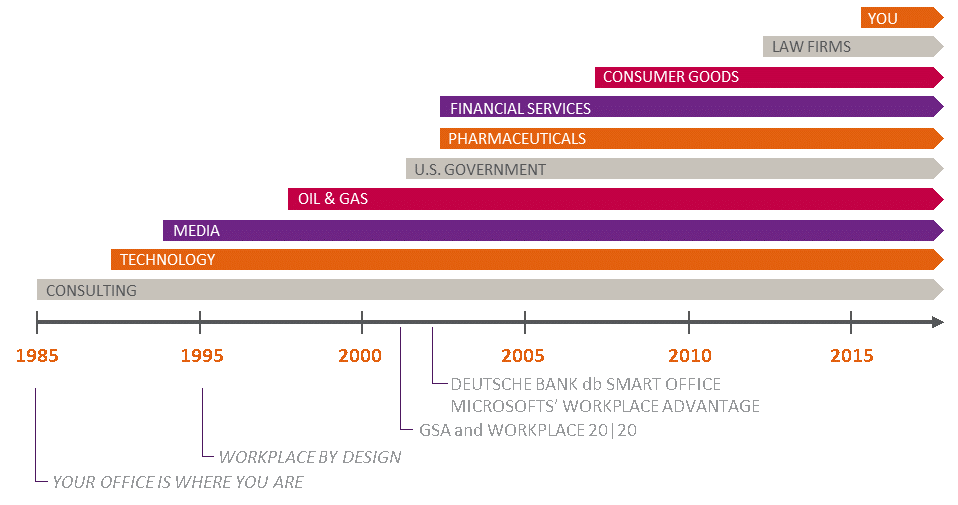
5 ½ things to know about workplace strategy
As workplace strategists, we get a lot of questions: What is workplace strategy and why is it so popular? Why should I engage an expert and how do I choose one? What can workplace strategy do for my company? With so many questions and even more answers floating around, it’s time to set things straight. Read on for 5 (and a half!) things you need to know about this workplace necessity.
1. Workplace Strategy is older than you think
Way back in 1985, well before we all had a tiny phone/computer/camera/GPS system in our pockets, Philip Stone and Robert Luchetti declared “Your Office is Where you Are” in the Harvard Business Review. Emerging technologies at the time, including cell phones, made the novel concept of working away from the individually assigned desk possible and soon the physical office began adapting to the idea of activity settings.
In 1995, the eminent book Workplace by Design by Cornell University’s acclaimed Franklin Becker and Yale University’s Fritz Steele hit the streets. This marked one of the first times the design of the physical workplace was directly tied to an organization’s business success. By 2002, the U.S. General Services Administration launched the Workplace 20|20 research and development program, bringing together a consortium of experts to develop a toolkit that enables Federal Agencies to realign work settings to support their business needs. This program evolved into GSA’s Total Workplace Program, which continues as standard practice today.
In 2005, the Journal of Corporate Real Estate published an article titled, “Workplace strategy: What it is and why you should care.” By this point, major corporations had jumped on board. Deutsche Bank was among the first companies to establish a strategy: db Smart Office (in 2002). Microsoft began researching its own ways of working in 2004/2005, eventually beginning the Workplace Advantage Program, which continues to evolve to this day.

2. It’s all about connections and efficiency
When done correctly, workplace strategy very closely aligns with overall business strategy, goals, and corporate culture, with the intent of supporting and benefitting all three. Robust workplace strategies integrate the physical workplace (space, branding and furniture) with technology, policies, and organizational excellence to answer important questions about the workplace: What does it look like? How do I use it? What tools do I have to produce the best work in the manner that is most efficient for the company?
And most critically, what works for one company will not necessarily work for another. We have seen far too many instances where someone sees a “cool” office and decides to implement the strategy in their own organization without any research or understanding. Needless to say, this is almost always a disappointment.
3. It’s one of the most popular ideas in business
The increasing focus on corporate real estate performance (cost!), while doing more with less, and tying workplace transformation to business drivers and productivity (profit!) is pushing companies to pay a tremendous amount of attention to the built environment. In addition, companies are looking for greater collaboration between business units and service providers, while expanding globally in daily operations and services.
By understanding the workforce, both how work is conducted today and how it will be done in the future, organizations are better able to plan their assets in a way that is more reflective of the business. A comprehensive strategy can then be developed to “futureproof” the physical workplace. Essentially, a strong workplace strategy helps companies make informed decisions, supported by data and thorough analysis, to avoid future catastrophes.
4. Any company can benefit from it
Strategies are not just for large companies, although most of the Fortune 100 have embarked on one (or more) strategy endeavors. Companies of all sizes – from 10 to 100 to 100,000 people – can benefit from a hard look at the way they work.
We find that the best reasons to embark on a strategy are when there are clear drivers at the corporate level (i.e., improve the bottom line), the business line level (i.e., make our teams work more effectively), and the individual level (i.e., provide the workplace that supports the way I work).
The most obvious time to look at a workplace strategy is when your company is about to sign a new lease or begin a major expansion or contraction. Other triggers for looking at new ways of working include major organizational change, implementation of new technology or changes in policy. When companies are making a substantial investment, they will sometimes study the workplace for years in advance of implementation. This enables testing of theories and policies well before the rubber hits the road.
Of course in any workplace strategy, ongoing executive and employee engagement is fundamental. This is part of change management and can be done in conjunction with the workplace strategy.
5. Calling in experts can save time and lower costs in the long-run
Organizations undergoing major change often look to multiple service providers to ensure that the strategy is the least biased best fit. For example, a company may look to a research organization, a real estate company and a design firm to bring different perspectives to an overall strategy. At CallisonRTKL, we team with our portfolio analysts, ethnographers, change managers, interior designers and technology designers to ensure a robust, integrated solution for our clients. With each strategy, we think about what the company is trying to achieve, and what types of tools will best support their unique culture and goals:
- Future view: we document core values and vision to define strategic workplace goals.
- Existing conditions: we assess what is working and what needs to be adjusted, and study the underlying causality.
- Work patterns: we identify common threads in the way people work, creating a strategy that works for both broad groups of people and specific worker types.
- Brand and image: we integrate the company’s look and feel into the future workplace.
- Market alignment: we examine where a company falls within the marketplace and, more importantly, where they want to fall.
5 ½. Choosing the right strategist can be complicated
Strategists come from a variety of backgrounds: you may find some with a background in architecture, interior design, urban planning, psychology, sociology, finance, real estate, or any variety of fields. Only in recent years have universities begun to offer specialties in workplace strategy. The best way to know if your strategist is qualified is to look at what types of projects they’ve completed, what types of organizations and events they participate in, and what their client outcomes have been. And make no mistake: a good workplace strategist can mean the difference between a highly productive, engaged workforce that skyrockets a company and a group of disconnected, high-turnover employees who can sink the bottom line.
